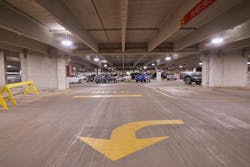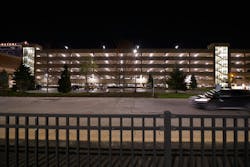Best Practices for Effective Lighting Projects
There are three main purposes for exterior lighting: to increase safety and visibility; create the right impression and atmosphere; and enhance security. Understanding the many important considerations and best practices that need to be implemented is key to achieving these goals and having effective lighting projects.
Good lighting distribution enhances security and safety
When it comes to proper outdoor safety, one of the primary concerns is visibility. Poor lighting conditions can make it difficult to navigate walkways, parking lots, parking structures, and other outdoor spaces. Well-designed exterior lighting increases the feeling of security for facilities’ employees and patrons, helps ensure that people don’t trip and fall, and plays a critical role in the prevention and deterrence of crime.
Since insufficient light can compromise safety, designs often focus on light output. While light levels are critical, poor distribution can create too much lighting in some areas and dark patches in others. In fact, according to Eric Richman, senior research engineer at the Department of Energy, “the conventional wisdom is that more light is better, but from a security standpoint, too much of the wrong kind of light, aimed in the wrong direction, can cause glare. Moreover, security camera function depends on various lighting factors including uniformity/contrast, light color, color rendition (CRI), and intensity.”
The Illuminating Engineering Society (IES) outlines the most important considerations for effective safety and security lighting:
- Horizontal illuminance is the standard for assessing effective lighting because many tasks are horizontal in nature.
- Vertical illuminance is critical for security issues because identifying objects and their movement is best done by viewing their vertical surfaces.
- Uniformity is important for avoiding dark areas and enhancing the effectiveness of security cameras.
Pole placements
Light poles are needed to mount luminaires for illuminating large, exterior projects, such as parking lots or outside tennis courts. One critical factor is the space between the poles. The goal is to have illumination bright enough that is suitable for the application and meets lighting requirements. Additionally, the light needs to be uniform across the area so that there aren’t sections that are dimmer or brighter than others across the same space. Replacing light poles is expensive, so while a retrofit project may include new luminaires, many times the pole spacing remains the same.
The poles’ height is also a factor to ensure best practices. Larger parking lots require taller poles spaced farther apart. Taller poles also need higher output luminaires.
If it’s a new construction project, getting involved early is ideal to recommend the pole heights, placement, and beam angles for the layout to ensure optimum light coverage.
Out with the old
While contractors and facility managers may be looking for a quick, easy, and inexpensive upgrade to their lighting system, there are downsides to consider when installing replacement LED lamps in existing fixtures. A replacement lamp may not offer the same light distribution. As outlined above, light distribution is a major consideration for commercial lighting best practices.
On the other hand, there comes a time when old luminaires just need to be replaced. Outdated or malfunctioning luminaires can hinder productivity, waste energy, and increase maintenance expenses. The impetus for this is often the inability to buy replacement parts, or the luminaires are so corroded that they can’t even be opened for repairs.
Fortunately, there are many benefits of an updated lighting system. Upgraded LED luminaires dramatically reduce power consumption from 50% to 75% compared to older technology. The new luminaires may also support broader sustainability and environmental, social, and governance (ESG) goals such as a smaller carbon footprint. Many facility managers are surprised to learn lighting upgrades often have a short return on investment.
Photometric layout
Another important lighting best practice is to have a photometric layout completed. This will provide a computer simulation of light levels. While this may seem rudimentary and common to have one, it surprisingly isn’t done on every project. This plan helps achieve the proper light levels throughout the space, ensuring enough illumination, wattage, and luminaire lens distribution — and not over-lit, causing wasted energy consumption — without causing eye discomfort or distractions from glare or shadows.
Photometric layouts also provide an accurate visual to determine if there are too many or too few poles in the space. The layout will also show if new poles should be added or moved on an upgrade project to provide more light uniformity.
Honest broker
As design engineers and electrical contractors, you play a unique role with your clients as an unbiased, honest broker. Providing invaluable counsel as to the most effective lighting system for each project positions you as a trusted, collaborative partner. Understanding and implementing these lighting best practices will help achieve each project’s specific goals.
About the Author
Bob Tortorello
Bob Tortorello is vice president at Wisconsin-based Optec LED Lighting. He can be reached at [email protected]. For more information, visit www.optecledlighting.com.



